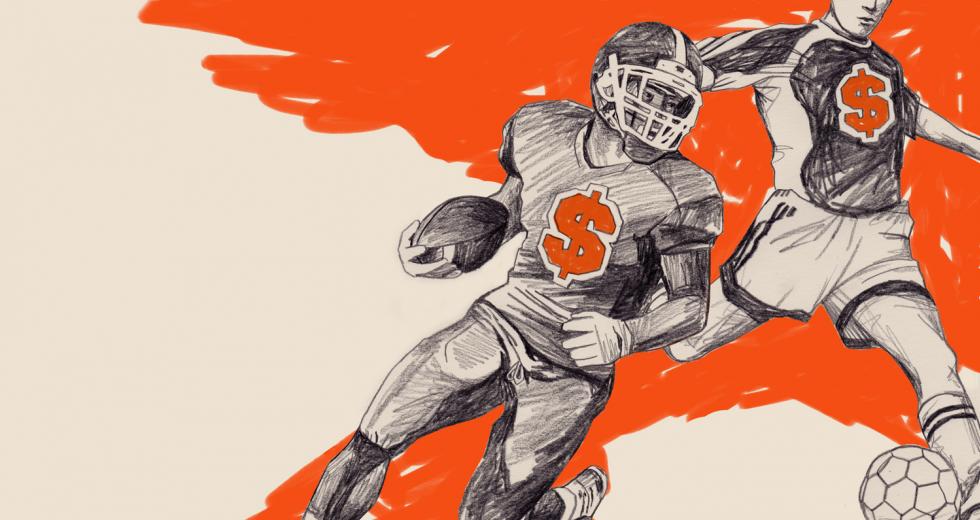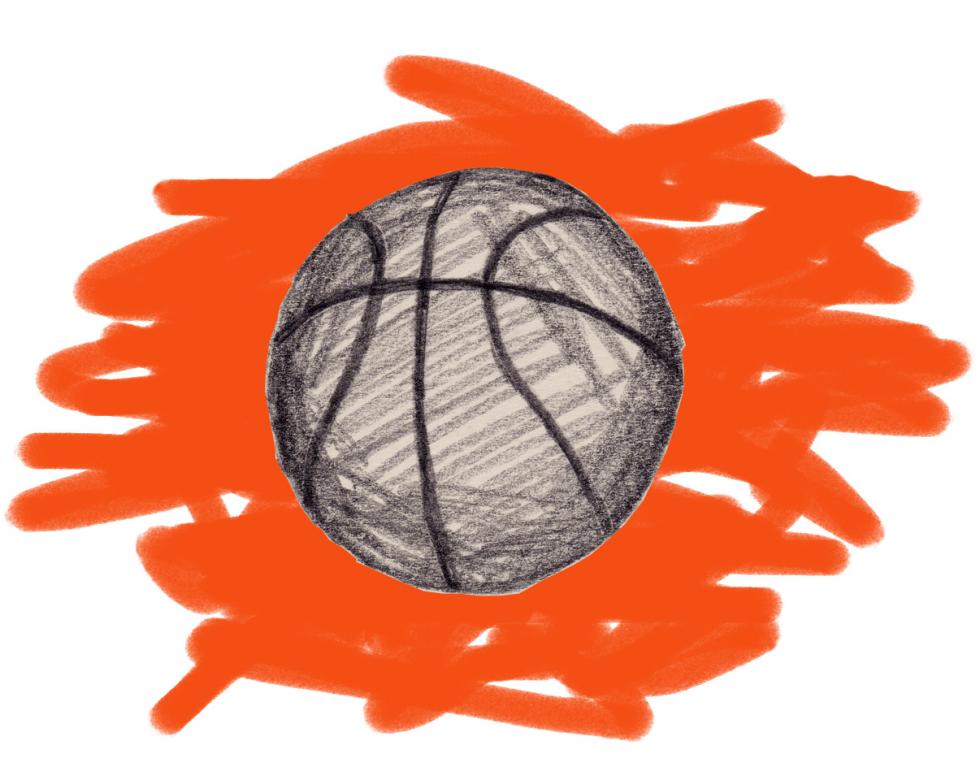High school freshman Kendall Kott packs up her textbooks, grabs her sports bag and boards the bus from her campus in Cameron Park to Roseville to compete in a varsity swim match on an April afternoon. She destroys the competition. Then Kendall, slim, tall and muscular, climbs into the car with her mother, Angela Kott, who drives them an hour away to Woodland, where Kendall practices on her competitive volleyball team. At 9 p.m., mother and daughter head home.
It’s a normal day for Kendall, now 15 years old. Her younger sister, Lauren, who is 13, also hustles from sport to sport. The weekends stay busy as the Kotts travel throughout California and all over the country — New York City, New Orleans, Denver, Spokane — for the girls’ competitions. This year, the family stayed in a hotel nearly every weekend from January to May. They spend upward of $20,000 a year on sports. “We must love it,” Angela says. “It’s a certain kind of crazy.”
The girls are cousins of mine by marriage, and we often talk about their sports, which have changed a lot since I played soccer growing up in Sacramento in the ‘80s and ‘90s. Parents of children in my generation encouraged recreational sports for the exercise, character-building, teamwork and fun. Then when I was a teenager, a shift occurred: More youth began participating in competitive (tryout-based), travel teams that practice more often and play additional games, often year-round, as parents shell out thousands of dollars per child, per sport, per year. The stakes are high. Or so they seem, as college scholarships or professional careers beckon at the finish line.
Kendall Kott plays in a beach volleyball tournament in
Sacramento. Kendall, 15, is an elite volleyball player and
swimmer. (Photo by Cole Allen)
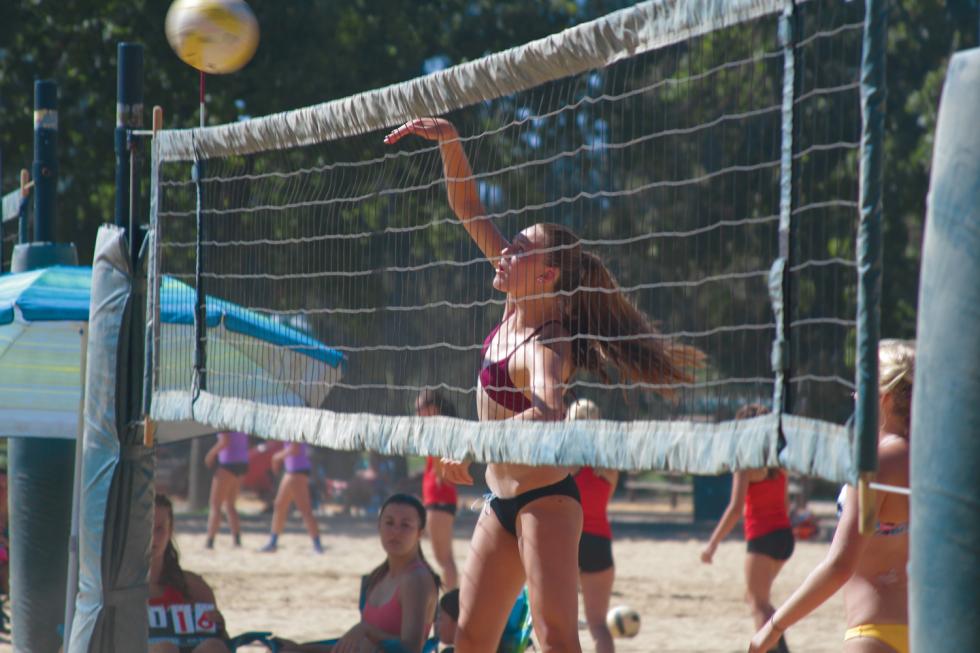
Zach Streight, executive director of the Positive Coaching Alliance’s Sacramento chapter, worries about the shift toward hypercompetitive sports because it reflects an uncomfortable reality: children as dollar signs. “I’m an economics, supply-and-demand, business kind of guy, but people don’t realize what the goal is of a professional youth sports organization,” Streight says. “They are in the business of getting people to pay to have them develop their child. They have an interest in getting as many paying customers as possible.”
If You Build It
In December 2012, the Sacramento City Council hit reset on its sports commission after the nonprofit foundation that oversaw it defaulted on a $400,000 loan. The council approved contracting the operations to the Sacramento Convention and Visitors Bureau. The bureau made Mike Sophia its director, responsible for attracting big sporting events, tournaments and conventions. The commission, for instance, oversees the Amgen Tour and previously the U.S. Olympics track and field trials.
Sacramento is a “sports town,” Sophia says. While big events that come here every few years like the NCAA men’s basketball tournament bring widespread excitement and make headlines, they don’t form the basis of the commission’s work. That would be youth sports tourism, which nationwide is an estimated $7 billion industry. “We’re an economic development organization,” Sophia says. “We want to bring people to stay in our hotels, eat in our restaurants and spend money while they’re here. Travel and tourism is cyclical like the economy. It goes in eight-year spurts and we’re starting to see a high again.” Families wrap their vacations around youth sports events.
Related: Youth Sports Should be a Kid’s Game
To grab more of that market, Sacramento needs the infrastructure. The first step involves evaluating the region’s needs, then identifying land, such as in Natomas. With the arena moving downtown (and with it, an important economic engine), perhaps the area is ripe for a different sports complex — one that caters to young athletes. “From an economic development standpoint, it’s really just good business,” Sophia says. “We want to be an advocate for sports in our community. I think sports is part of the fabric of our community, and of a lot of communities.”
Several years ago, the City of Roseville realized that fields for organized sports in neighborhood parks had reached capacity. Since then, Roseville has continued to grow — to 130,000 residents from 78,000 in the 2000 census — and attract young families, making the need for sports fields and facilities even more pronounced. Most of the city’s soccer fields and basketball courts are in the middle of residential neighborhoods, without space for the multiple fields needed for tournaments or the stadium lighting that enables athletes to play into the evening. “Cities are trying to place larger, regional-draw facilities outside of the neighborhoods and leave the neighborhood parks to the neighborhoods,” says Assistant City Manager Dominick Casey.
Roseville is doing the same. The City is collaborating with Placer Valley Tourism on the $40 million Placer Valley Sports Complex with 10 lighted, all-weather fields for “really any field sport you can imagine,” Casey says, including quidditch (of Harry Potter fame), soccer (Roseville boasts over 6,000 youth soccer players and anticipates that number to more than double over the next two decades) and lacrosse and field hockey — two sports growing at a rapid pace. The project’s environmental review process is underway with construction expected to begin in spring 2017. The 55- to 60-acre complex will create up to $12 million in annual economic impact.
“People don’t realize what the goal is of a professional youth sports organization. They are in the business of getting people to pay to have them develop their child. They have an interest in getting as many paying customers as possible.”Zach Streight, executive director, Positive Coaching Alliance Sacramento
Feeling the Heat
Six years ago, Streight, who coached his son’s soccer team, attended a workshop held by the Positive Coaching Alliance, a Bay Area-based nonprofit organization founded in 1998 that helps coaches, parents, schools and athletes create a positive culture in youth sports. Streight describes himself as having been a highly competitive coach who didn’t realize the negative impact of his behavior until that workshop.
He soon became executive director of the organization’s local chapter. “It was exactly what I felt I should be doing,” he says. The Sacramento chapter last year held 90 workshops to impact 20,000 kids. They plan to reach 30,000 children this year — and the need is more critical than ever, he says, as inappropriate behavior in youth sports has spun out of control. Referees have been threatened by angry fans upset with a call. Parents yell at young children and parents fight in the stands. Coaches want to win at all costs.
A lot of that has to do with the money tied up in youth sports and the belief that a child’s future is on the line. Parents are paying customers to which entrepreneurs sell an elite vision of high-end sports on the journey to college scholarships and professional careers — if only their child signs up for this camp, and then the next one. These businesses tap into a parent’s fear of not giving their child an edge in life. “It’s the idea of not doing enough for my kid to be successful,” Streight says. “If we don’t do this clinic or camp, then the right coach isn’t going to see him and he’s going to get left behind.”
Some children are exceptionally talented, but in reality, most aren’t. The majority won’t get scholarships to play college sports. Even fewer will go onto professional careers. For instance, one in 30 high school senior boys will go on to play in an NCAA institution, and only three in 10,000 high school senior boys playing basketball will eventually be drafted into the NBA, according to research from the NCAA. Those percentages improve slightly for football and baseball, and a bit more for ice hockey.
“They need people thinking their kids are elite athletes so they get a fee every month … that then triggers the pressure because then, all of a sudden, mom and dad are paying $300 a month for this,” Streight says. In recreational sports, it’s not a big deal if a child loses interest. But in competitive sports, this disinterest poses a problem for parents who have already paid thousands of dollars.
Lauren (right) and Kendall Kott take a break during a recent
beach volleyball tournament in Sacramento. (Photo by Cole Allen)
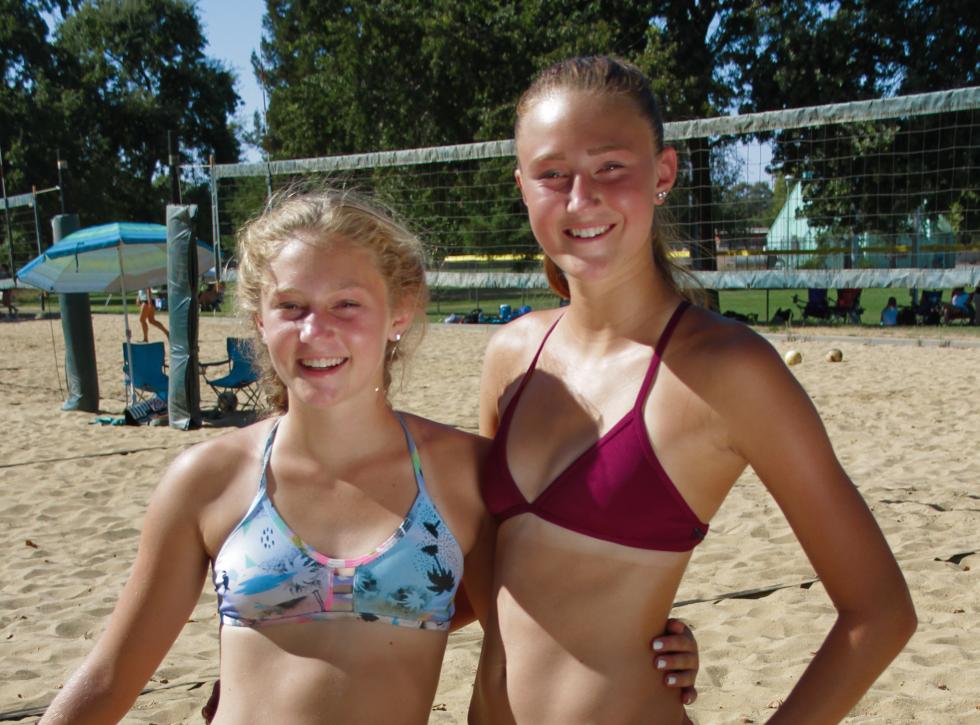
The benefits of sports can be enormous and lifelong. Studies have shown that when girls in particular play sports they develop a healthier body image. They’re also less likely to do drugs, less likely to get pregnant and more likely to graduate high school than their counterparts. But increased specialization in youth sports today — like only playing one sport, or trying to get a boy in Little League to master his baseball pitch — can lead to early burnout and repetitive-use injuries. Boys are blowing out their shoulders. Girls on competitive soccer teams are tearing their ACLs. Every year, more than 3.5 million children under age 15 need medical treatment for sports injuries — nearly half caused by overuse, according to journalist Mark Hyman’s 2010 book, Until It Hurts: America’s Obsession with Youth Sports and How It Harms Our Kids.
Are today’s children experiencing as much joy out of youth sports at they once did? That’s hard to say. An alarming and ubiquitous statistic often used to argue “no” is that 70 percent of youth leave organized sports by age 13, according to the Institute for the Study of Youth Sports at Michigan State University. This stat is used again and again in the literature of youth sports organizations. But Dr. Andy Driska, an assistant professor in the institute, says that’s an old statistic and “could have changed over the past decade.” Reliable comprehensive data is difficult to come by as the world of youth sports is fragmented and decentralized.
MSU’s institute studies specialization versus general sports participation — and the motivations for specializing. “A lot of parents may not really think about, ‘Is this the right thing for my child to be doing right now?’” Driska says. He suggest parents ask their children what they want out of sports. “One of the biggest reasons why kids want to play is to have fun and play with their peers.”
Certainly, he says, the trend has been toward competitive sports. “It probably starts with how recreational opportunities aren’t really funded how they used to be. Funding in parks and recreation departments have dried up, especially in places with not as much wealth.” As the economic model in youth sports has shifted from municipal-funded to privately-funded leagues, wealthy parents are spending more money for their kids to play sports, and children in low-income families are left behind.
‘Why Do I Do This?’
Over the Fourth of July weekend, I stop by the Sacramento Softball Complex to watch Kendall and Lauren play in a casual beach volleyball tournament together. The girls finish their game and plop down on a blanket in the shade near their parents. They snack on watermelon and show off their haphazard tan lines (from the different swim suits they wear). A few days earlier, Kendall and her father were in Indianapolis for the Junior National Championship in girls volleyball; they took second place in their age group. Lauren and her mother were in Santa Cruz for a beach volleyball tournament. “Loving every second!” Angela posted to Facebook.
Today she’s not so sure. She’s conflicted, as are her daughters. “I don’t like how it’s stressful on the body afterwards,” Lauren says. “And sports take up time — a lot of time. And you have so much school work.” She does art or hangs out with friends to take her mind off school and sports.
Lauren Kott plays volleyball and is a swimmer. (Photo by Cole
Allen)
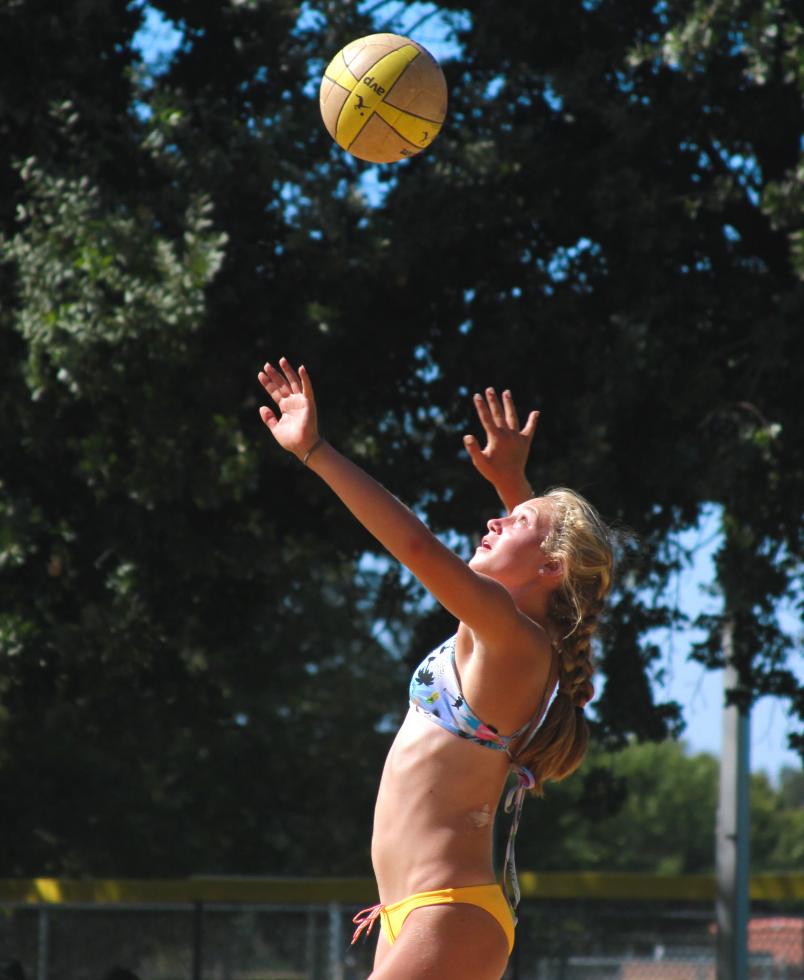
For Kendall, the pressure is higher because she’s already in high school and playing at an elite level. “There’s a lot of time when you’re like, why do I do this? And then if you get a good hit or a nice set, you’re like, oh that’s why.” Her competitive volleyball team — led by a legendary Sacramento State coach Debby Colberg— is stressful. “Coaches are tough and they’ll be tough on you, and you have to fight for your spot,” she says. “You’re fighting with your teammates for your spot. Like, if there’s two setters, you can’t have two setters on the court at once. You’re like, ‘I love them, but I have to beat you so I can play.’”
The Kotts don’t expect their daughters to get college scholarships. But should they want them, their parents remind the girls they’ll have to work for it. Elite athletes don’t simply attend practice: They do clinics, private lessons, camps, all things that cost more money for parents. If Kendall wants to swim in college, her parents say she should already be swimming three hours in the morning and two in the evening. But, she points out, it’s hard waking up at 5 a.m. to practice. Yet Kendall says she loves playing sports … “mostly,” and they give her a sense of accomplishment, even when she’s bouncing from school to game to practice to homework: “It’s a long day but then at the end, you’re really proud of yourself and it’s all worth it. You’re better for it.”



